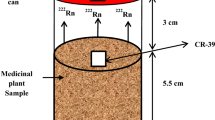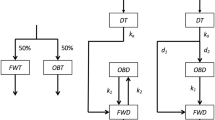Abstract
RADIOACTIVE isotopes as indicators in biological problems were first used by Hevesy1. Recent progress in the production of artificial radioactive substances makes this field of research one of the most promising, and 32P, the radioactive isotope of phosphorus with a decay period of 14 days, has already been used as an indicator in animal and plant metabolism2.
This is a preview of subscription content, access via your institution
Access options
Subscribe to this journal
Receive 51 print issues and online access
$199.00 per year
only $3.90 per issue
Buy this article
- Purchase on Springer Link
- Instant access to full article PDF
Prices may be subject to local taxes which are calculated during checkout
Similar content being viewed by others
References
Hevesy, G., Biochem. J., 17, 439 (1923).
Hevesy, G., and others, NATURE, 136, 754 (1935); 137, 66 (1936); 139, 149 (1937). Chiewitz, O., and Hevesy, G., Dansk. Videnskab. Selsk. (Biol. med.), 13, 9 (1937).
Artom, C., Arch. Fisiol., 32, 57 (1933); Arch. intern. Physiol., 36, 101 (1933). Artom, C., and Peretti, G., Arch. intern. Physiol., 36, 351 (1933); 42, 61 (1935–36).
Sinclair, R. G., J. Biol. Chem., 92, 245 (1931); 95, 393 (1932); 96, 103 (1932); 111, 275 and 515 (1935).
Author information
Authors and Affiliations
Rights and permissions
About this article
Cite this article
ARTOM, C., SARZANA, G., PERRIER, C. et al. Rate of Organification of Phosphorus in Animal Tissues. Nature 139, 836–837 (1937). https://doi.org/10.1038/139836a0
Issue Date:
DOI: https://doi.org/10.1038/139836a0
This article is cited by
-
Experimentelle Untersuchungen am Hund zur Pathogenese der nephrotischen Hyperlipidämie
Zeitschrift für Die Gesamte Experimentelle Medizin (1962)
-
Untersuchungen �ber den �bergang markierter Phosphate in das Nervensystem, eine spezielle Anwendung der Indikatormethode
Die Naturwissenschaften (1946)
-
Formation of Radio-Phospholipid by Isolated Tissues of the Rat
Nature (1938)
-
Lecithinæmia following the Administration of Fat
Nature (1937)
-
Phospholipid Synthesis during Fat Absorption
Nature (1937)
Comments
By submitting a comment you agree to abide by our Terms and Community Guidelines. If you find something abusive or that does not comply with our terms or guidelines please flag it as inappropriate.



